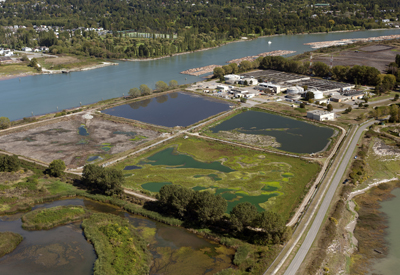Encourage Your Industrial Customers to Adopt Green Practices
Most industrial facilities discharge wastewater to publicly owned treatment works (POTW) for treatment. When industrial users reduce effluent volume and loading, they positively impact their wastewater treatment plant. Reducing wastewater loading from industrial users helps POTWs meet the National Pollutant Discharge Elimination System (NPDES) permit limits and create additional treatment capacity without the need to expand. POTWs can help their industrial users reduce wastes, cut costs, and meet regulatory requirements.
Visit MnTAP’s Greening Your Business Web pages for BOD/TSS Loading and Phosphorus information that may be helpful to your industrial users. Encourage your industrial users to green their business practices.
Resources
- MnTAP Fact Sheet: Water Conservation Tips. This fact sheet will help businesses understand their water use and look for opportunities to reuse and conserve water.
- MnTAP Source Article: Site visit leads to phosphorus reduction (pg 4) The company reduced 8,650 lbs. per year of phosphorus discharge to the City and saved $100,000 in costs associated with the avoided purchase of chemicals and discharge to the treatment facility.
- MnTAP Case Study: Concrete Manufacturer Reduces Water Use and Solid Waste (2007)
- Environmental Protection Agency: Pollution Prevention at POTWs Case Studies [PDF 2,752KB]
- Metropolitan Council Environmental Services (MCES) Resource: MCES Strength Charge Formula. The MCES Strength Charge Formula estimates strength charges based on the amount of waste chemical oxygen demand (COD) and total suspended solids (TSS). Note: MCES provides wastewater treatment for much of the Twin Cities seven county area. If your industrial facility is outside of the metro, you may be subject to strength charges imposed by your community.
Reports
- MnTAP Report: Cost Effective Pollution Prevention Strategies to Reduce Phosphorus in the Minnesota and Lower Mississippi River Basins [PDF 124KB]. MnTAP worked in partnership with operators of wastewater treatment plants to provide pollution prevention outreach and implementation assistance to industrial users of municipal treatment systems in southern Minnesota. During the course of this two-year project with McKnight Foundation support, MnTAP helped companies reduce 30,800 phosphorus, 3.03 million pounds of organic and solids loading, 66.5 million gallons water, and save $2.8 million.
- MnTAP Report: Pollution Prevention for Industrial Wastewater Dischargers in the Upper Mississippi River Basin Using City-wide Inventories [PDF 104KB]. MnTAP worked in partnership with operators of wastewater treatment plants to provide pollution prevention outreach and implementation assistance to industrial users of municipal treatment systems in the Upper Mississippi River Basin. During the course of this two-year project with McKnight Foundation support, MnTAP helped companies reduce 35,100 pounds of phosphorus, 4.5 million pounds of biological oxygen demand (BOD) and total suspended solids (TSS), 37 million gallons of water, and save $348,000.